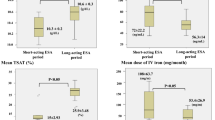Abstract
In our earlier paper [1] we found that among 50 hemodialysis patients(HD pts) 48% (24 pts) control anemia with hemoglobin (Hb)concentration >9.5 g/dl and hematocrit (Hct) >30%without recombinant human erythropoietin (rHuEpo) therapy. These HD ptshad significantly higher mean endogenous erythropoietin (eEpo) level andlower iron reserves (IR) than HD pts who need rHuEpo therapy. The aim ofthis study was to judge whether the possibility to control anemia in ptsnot requiring rHuEpo therapy changes during a 30-month HD treatment.Serum eEpo and ferritin were measured every 6 months. After 30 months ofHD treatment 18 pts remained in this group – 5 pts died, Iunderwent transplantation. During the study period 4/18 ptspermanently had a very low level of eEpo (under detection limit),7/18 had the level of eEpo within normal range for healthy control,7/18 pts had a high level of eEpo (up to 3 times higher than themean for healthy control). Pts who had the highest level of eEpo had thelowest IR. After 30 months IR were significantly lower than at thebeginning of observation (292 ± 87 vs 143 ± 127 mg).Important negative correlation between eEpo and IR was observedthroughout the whole period of study: r = −0.4820,p < 0.02 at the start of the study, and r =−0.6126, p < 0.007 after 30 months of treatment. Thestudy shows that the possibility to control anemia in pts not treatedwith rHuEpo did not change significantly during 30 months of HDtreatment. Endogenous Epo level in HD pts not treated with rHuEpo variedbetween different pts: it was permanently low in some pts, permanentlyhigh in others and stayed normal in remaining pts.
Similar content being viewed by others
References
Majdan M, Książek A, Kozioł M et al. Comparison of plasma erythropoietin concentration and iron status in hemodialyzed patients not requiring and requiring rHuEpo therapy. Nephron 1996; 73: 425
Erslev AJ. Erythropoietin N Engl J Med 1991; 324: 1339
Eschbach JW. Hematological problems of renal failure. In Jacobs C, Kjellstrand CM, Koch KM, Winchester JF, eds. Replacement Renal Function by Dialysis.Dordrecht-Boston-London: Kluwer Academic Publ., 1996
Korbet SM. Anemia and erythropoietin in hemodialysis and continuous ambulatory peritoneal dialysis. Kidney Int 1993; 43: S111
Winearls CG. Recombinant human erythropoietin: 10 years of clinical experience. Nephrol Dial Transplant 1998; 13, S3
Lacombe C, Mayeux P. The molecular biology of erythro-poietin. Nephrol Dial Transplant 1999; 14: S22
Anastassiades EG, Howarth D, Howarth J et al. Monitoring of iron requirements in renal patients on erythropoietin. Nephrol Dial Transplant 1993; 8: 846
Ratcliffe PJ. Molecular biology of erythropoietin. Nephrology forum. Kidney Int 1993; 44: 887
Inomata S, Itoh M, Imai H, Sato T. Serum levels of erythro-poietin as a novel marker reflecting the severity of diabetic nephropathy. Nephron 1997; 75: 426
Ifudu O, Friedman EA.Effect of increased hemodialysis dose on endogenous erythropoietin production in end-stage renal disease. Nephron 1998; 79: 50
Majdan M, Książek A, Spasiewicz D. Plasma erythropoietin level and iron reserves in hemodialysis patients with and without acquired cystic kidney disease.Intern Urol Nephrol 1997; 29: 113
Ishikawa I, Onouchi Z, Saito Y et al. Sex differences in acquired cystic disease of the kidney on long term dialysis. Nephron 1985; 39: 336
Sandhu S, Silbiger SR, Lei J, Neugarten J. Effects of sex hormones on fluid and solute transport in Medin-Darby canine kidney cells. Kidney Int 1997; 51: 1535
Congote L, Brox A, Lin FK, et al. The n-terminal sequence of the major erythropoietic factor of an anephric patient is identical to an insulin-like growth factor.J Clin Endocrin Metab 1991; 72: 727
Stenvinkel P, Heimbürger O, Lönnovist F, Barany P. Does the ob. Gene product leptin stimulate erythropoiesis in patients with chronic renal failure. Kidney Int 1998; 53: 1430
Majdan M, Kotarski J, Książek A. Serum erythropoietin and sex hormones in hemodialysis patients who do not need Epo supplementation and those requiring rHuEpo therapy (abstract). Nephrol Dial Transplant 1996; 11: A262
Majdan M, Książek A. Relations between ability to control anemia by hemodialysis patients and serum concentrations of Epo and IGF-1. Nephrol Dial Transplant 1997; 12: A189
Majdan M, Kotarski J, Książek A, Grzebalska A. Concentra-tion of leptin and anemia control in hemodialysis patients. Pol Arch Med Wewn 1999; 101: 295
Author information
Authors and Affiliations
Rights and permissions
About this article
Cite this article
Majdan, M., Książek, A., Bednarek-Skublewska, A. et al. Changes of endogenous erythropoietin level and iron status during a 30-month hemodialysis treatment of a group of patients. Int Urol Nephrol 33, 541–546 (2001). https://doi.org/10.1023/A:1019558511411
Issue Date:
DOI: https://doi.org/10.1023/A:1019558511411




